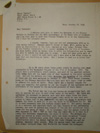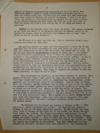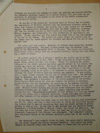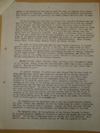|
|
| |
This letter is part of the International Institute for Social History's Alexander Berkman archive and appears in Anarchy Archives with ISSH's permission.
|
Group "Amshol"
Benj. Axler, Sec'y
3441 Giles Place, L - 22
Bronx, N.Y.
U.S.A.
Nice, October 18, 1932
Dear Comrades:
I welcome your plan to issue the Speeches of the Chicago Martyrs in Yiddish for the 45th anniversary of the Black 11th of November. And I am also glad to note that Comrade Frumkin is to do the translation, for I know his splendid work.
I regret, however, that you did not communicate with me in this matter before. Comrade Axler's letter of Sept. 25th, asking me to write an Introduction to the book reached me only to day, October 18th. As the Yiddish translation is to appear for the 11th of November, you have hardly given me enough time to write the Introduction and to reach you with it before the book goes to press. I have not been quite well of late, so that I cannot do much work; and I have also a few other things on hand that are requiring my labor. But I hasten to send you a little contribution.
It is 45 years since those great events in America that culminated in the Haymarket tragedy of the 11th of November, 1887. The people have a proverbially short memory, and most of the American workers today have not the least idea of what happened in the Labor movement then. And yet the workers are today enjoying the benefits of the efforts of those men who were martyred in Chicago in 1887. Those social pioneers, known as the Chicago Anarchists Martyrs, have paid with their lives in order to advance the cause of Labor. Their death was a fearful tragedy for labor and humanity, greater is yet the tragedy of the ignorance and indifference of the masses to the martyred pioneers of their cause.
The 8-hour day has long ago become an accomplished fact, not only in America but also in most other parts of the world. But those who initiated the movement in America have paid with their lives for their efforts. The average American working men today would be very much surprised to learn that it was ANARCHISTS who were the first to proclaim that demand, the first to work for it and the first to be martyred for it. But it is most necessary that the workers should know it. Not merely because it is a historic and important fact; not only because of any sentimental reasons, nor even injustice and respect of the men who sacrificed their lives for the cause of labor. It is necessary that the masses should know what happened in 1886 - 1887 so that they may learn who it is that is fearlessly and devotedly championing the cause of Labor. The workers are duped and misled by every political party and every so-called "liberal" and would-be revolutionary group that there can be no hope of any social clarification until the masses realise who their friends are and who are their enemies, whatever their colors. When the masses learn that politicians have always betrayed them, that Socialism has become the strongest
|

|
|
2
|
|
|
support of despotic government and capitalism all over the world, that Bolshevism means a return to fuedal dictatorship and abject slavery -- when the workers learn that, and when they are shown that ONLY Anarchists have never sought to dominate and exploit the masses -- that on the contrary, the Anarchists have always been the martyrs for the cause of Labor, as our Chicago comrades and many others all over the world have been -- then the masses will lend a more willing ear to the ideas and ideals of Anarchism.
EXAMPLE is the powerful lever that moves the world. The example contained in the lives and deaths of the Haymarket Martyrs is powerful enough to enlighten the masses, could we but bring that example home to them. That should be one of our main endeavors.
But 45 years is a very long time ago. Let us therefore briefly recapitulate the events of those days.
The American workers in those days were compelled to slave 12, 14 and sometimes even 16 hours, incredible as such long hours may seem to day. In very rare exceptions, in but a few industries, the work day was 10 hours. It was the most advanced elements of those days -- the Revolutionary Socialists, particularly those of them who called themselves Anarchists -- who initiated the labor demand of the 8-hour work day. It was in those days a more "extreme" demand than a 2-hour work day would be today. To the parliamentary Socialist of those days the new demand was only a matter for theoretical discussion and Congress resolutions. But the revolutionary Socialists that had emancipated themselves from parliamentarianism, and particularly the Anarchists, proclaimed the motto of an 8-hour day in an energetic and decisive manner. They began to organize the workers to make the demand practical, to carry it out and life.
Thus originated the beginning of the 8-hour movement in America. As a matter of historic truth I must point out here that even some Anarchists of those days lacked sufficient vision to understand the organizational, propagandistic and revolutionary value of the movement. Some of them, as Johann Most, for instance, naively believed that it would be just as easy to inspire the workers to strike against the whole capitalist system as to induce them to strike for the 8-hour day. Events proved them wrong, of course. The laboring masses, particularly in America, were far too unenlightened socially to even dream of abolishing capitalism -- and as a matter of fact they do not seem much more enlightened today. But a strike for a shorter work day they could well understand. More, they felt that it concerned their immediate daily interests, and such a struggle therefore quickly appealed to the working masses.
The movement for of the 8-hour day started in Chicago on May 1, 1886, and soon spread throughout the country. Its beginning was marked by strikes in most of the large industrial centers. 25,000 workers laid down their tools in Chicago on the first day of the strike, and within two days the number was doubled. The Chicago Anarchists, particularly the good speakers among them -- Albert Parsons, August Spies, Adolph Fischer, Michael Schwab and Samuel Fielden -- were the heart and soul of the movement. Their year-long activity among the laboring masses of Illinois had secured for them the respect and attention of the workers. They were looked upon as true friends and teachers, and their words were listened to. Our comrades en-
|

|
|
3
|
|
|
couraged and inspired the strikers by their own untiring and devoted efforts; the immediate practical demand for a shorter workday also gave them the opportunity to enlighten the masses on the evils of the entire governmental and capitalist system.
By the 4th of May almost all unionised labor of Chicago was on strike. The bourgeoisie of Illinois realised that the eight-hour movement, which at first they treated as utopian, was growing into a real danger for the bosses. Indeed, the capitalistic interests felt that the labor rebellion, spreading all over the country and led by intelligent and incorruptible men like our Chicago Comrades, was threatening the very foundations of exploitation and slavery. It was therefore not long before the armed fist of the law hastened to the aid of the bosses. The capitalist press, always the servile tool of the powers that be, raved against the strikers and called for the use of lead against them.
The police got into action. Meetings of strikers were assaulted, workers arrested and maltreated. The most vicious attack upon the strikers took place at the McCormick Harvester Works in Chicago. The police and Pinkertons deliberately shot a volley into the assembled strikers, killing four and wounding a score of others. Though the audience was justly indignant at the wilful murders committed against workers by the police, the meeting was quiet and orderly. The Mayor of the City, Carter Harrison, was present. He listened to several speeches and then -- according to his own sworn testimony later on in court -- he returned to police headquarters and informed the Chief of Police that the meeting was peaceful. It was growing dark -- heavy clouds overcast the sky and it looked like rain. The audience began to disperse, and only about three hundred persons remained at the gathering. Then suddenly a detachment of 170 police appeared at the meeting. Police Captain Ward raised his club and ordered the meeting to disperse. Samuel Fielden, who was addressing the gathering at the moment, replied: "This is a peaceful gathering". Captain Ward turned to his men and gave some order. Without further warning the police threw themselves upon the people, viciously clubbing men and women. At that moment something came whizzing through the air. It fell between the first and second rows of the police with a powerful explosion. Seven policemen were killed and sixty wounded; of the workers four were killed and about fifty wounded.
No one knew who threw the bomb; even to this day it has not be ascertained who did it. There had been so much brutality by police and Pinkertons against the workers that it was not surprising that some one should express an active protest by such an act. At one time it was claimed that the Anarchist Rudolf Schnaubelt, a brother-in-law of Michael Schwab, had thrown the explosive. But the rumor was never proven. Most likely the rumor was due to the fact that Schnaubelt disappeared from Chicago soon afterwards. But Schnaubelt himself most decisively denied in the European Anarchist press that he had thrown the bomb.
But whosever's hand actually threw the bomb, the person really responsible for the entire tragedy was Police Inspector Bonfield. Just before the catastrophe he received orders from Mayor Harrison to return with his police re-
|

|
|
4
|
|
|
serves to the station as there was no need for them, the meeting being peaceful and about to terminate. Instead of that, Inspector Bonfield gave Captain Ward orders to attack the gathering the moment Mayor Harrison left the meeting.
It was no secret in those days in Chicago that Inspector Bonfield was the paid tool of the "Citizens' Association", the organisation of the big capitalists of Chicago, who were determined to stifle rebellious labor in the blood of the workers. They had openly declared that they would down the eight hour movement and that they would "teach the rebels a lesson". The money interests of Chicago and of the State of Illinois had long boasted that they would "get" the "anarchist leaders". They meant to terrorise labor by murdering their most intelligent and devoted spokesmen, and these were Albert Parsons, a man of old American stock whose forebears had fought in the American Revolution; August Spies, editor of the Chicao "Arbeiterzeitung"; Adolf Fischer, George Engle, Louis Lingg, Michael Schwab and Samuel Fielden.
The trail of those seven men was the most hellish conspiracy of capital against labor in the entire history of America. From Judge Joseph E. Gary, District Attorney Grinnell, down to the hand-picked jurymen and bribed or terrorised witnesses, the entire bunch represented the acme of judicial racketeering and legal murder. Perjured evidence, bribed testimoney, police vengeance, aided by the raving capitalist press combined to bring about the cold-blooded assassination of our Chicago Comrades.
Parsons, Spies, Fischer, Engel and Lingg were condemned to death on the gallows. Lingg, young and irreconcilable rebel that he was, preferred suicide. Fielden and Schwab were sentenced to prison for life, while Oscar Neebe received 15 years.
No greater travesty of justice was ever staged than the mocj [sic] trial of these men who have justly gone down into history as the Chicago Anarchist Martyrs. What an outrage the trial and sentence were, even from a legal viewpoint, can be judged from the action of John P. Altgeld, Governor of Illinois in later years. After carefully reviewing the proceedings at the trial of the Chicago Anarchists he declared that the executed and imprisoned men had been the victims of a plot of the maufacturers, the courts and the police. He could not undo the judicial murders -- he could not bring the foully murdered back to life. But he courageously liberated the still imprisoned Anarchists, publicly stating that it was not an act of clemency on his part and that he was not "pardoning" them; on the contrary, he was merely making good, he said, so far as was in his power, the terrible crime committed against the condemned men.
The vengeance of the exploiters went so far as to mark Governor Altegeld for their victim: they punished him for his brave stand by quickly eliminating him from the political life of America. Indeed, the first and most criminal racketeers of America are the political and industrial bosses of the land.
The Haymarket Case, as the martyrdom of our Chicago Comrades is known, is the most powerful example of the kind of justice the masses get from their masters. The history of American labor is replete with such examples. On a smaller scale the Chicago judicial murders of 1887 are repeated in every
|

|
|
5
|
|
|
labor struggle. Remember the murders of unarmed strikers in the hopfields of Wheatland, California, in 1913; the Ludlow chapter in the State of Colorado, when the militia set the strikers' tents on fire and burned men, women and children alive, in 1914; think of the similar treatment of striking workers in Everett, Wash., in 1916; in Tulsa, Oklahoma; in Virginia and Kansas and Arizona; in the copper mines of Montana and in the numerous other places throughout the country.
Think also of the Mooney-Billings case and the Sacco-Vanzetti case. They are too recent to need detailing here. The lesson of these two cases, as of all the others, is the same as that of the Haymarket Martyrdom: nothing so arouses the hatred and vengeance of the masters as the effort to enlighten their victims. This is as true today as it was in the time of the Inquisition. Capital and Government fall upon and tear to pieces any one who dares shake the foundations of their tyranny and despotism. Teach the workers to stop hoping for "justice". There is not and cannot be any justice in a social system of exploitation and robbery. Emancipate the masses from their political superstitions and infantile social notions. Between capital and government on one side, and the laboring masses on the other, there is a fight to the death. Only the organised economic power of the working masses inspired by conscious social purposes can free the masses from their bondage. Hold up to them the example and ideals of our Chicago Martyrs to inspire them in the great struggle for a new world.
Nice
October 1932
|

|
|
This page has been accessed by visitors outside of Pitzer College times since December 22, 2000.
|
|